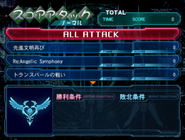| Series |
Galaxy Angel II is the successor and sequel to the original Galaxy Angel series. It features a new cast of Angels in the Rune Angel Wing that are related in some way to the previous members of the Angel Wing. The series differ through each medium, much like the first series but are all sequels to the original mediums.
The primary medium of the Galaxy Angel II series where its main character Kazuya Shiranami enters the Rune Angel Wing onboard the Luxiole under Tact's command.
- Galaxy Angel II: Gate to the Absolute
- Galaxy Angel II: Key to the Infinite Corridor
- Galaxy Angel II: Eternal Recurrence
The trilogy was adapted into the following media:
- Galaxy Angel 3rd: A manga series based on the first game.
- Galaxy Angel Rune: A slapstick comedy TV anime series adaptation following the original anime adaptation.
[]
- New Game: Starts a new game from the beginning of each game. The cursor will always start with New Game selected if the game is booted up for the first time. All other occasions will have it automatically put to the Load Game option.
- Load Game: Load from one of six available save slots with the option to choose from which Intermission to continue from a cleared Chapter.
- Options: Select Opening sequences, difficulty, and manage sound levels.
- Data: View CG, Music, and replay battles.
- Tutorial: A thorough guide to controls in combat narrated by Coco.
- Disk 2 Content: MK and EK has its option to access its Disk 2 Content on the main menu. The MK content features Kazuya's Solo Route in ZR while the EK content has Natsume's route in MK.
Load Game[]
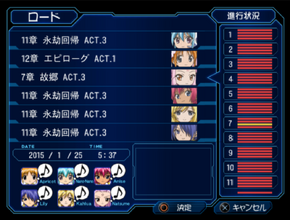
There are noticeably less save slots available for the player with only 6 available in all three games. The reason for this is that, like the first trilogy, a chapter is divided into several sections and are separated through Intermissions but the second trilogy games allow the player to select not only the chapter but also anywhere from the beginning of 1 out of 4 intermissions that each chapter contains. Similar to the anime, short scene changes are accompanied by a small transition effect while intermission scenes feature an eyecatch, usually featuring a character of importance in the chapter, the chosen heroine, and at the final eyecatch to signify the end of a chapter, the full Rune Angel Wing cast. In ZR, the team's overall affection levels (hearts) are shown while the successive games show the team's current trust Levels (musical notes).
Options[]
- Text Speed: Slow/Normal/Fast
- Controller Vibration: On/Off
- Text Skip: Read Only/All
- Mission Difficulty: Normal, Hard, Mania
- Opening Select
- Sound: Stereo/Mono
- Kazuya Voice: On/Off
- Character Voice Level
- Background Music Level
- Special Effects Level
- Cutscene Volume Level
Data[]
In both ZR and MK, the Data/Gallery Menu showcase the 5 heroines' respective CG's while the 6th batch of showcase the general CG's that occur. The unmarked button features Score Attack mode where missions can be replayed and the Extra EX missions that are outside the story can be accessed. Beneath all this is the music player that allows for tracks from the games to be played.
In EK however, the Data Menu became highly separated as the Menu now holds more features. First and foremost is the Chapter Selector, that allows the player to replay Chapters 1-9 while being able to select not only Kazuya's Angel but Tact's as well. The second menu is the regular CG Gallery with 8 batches in total, 6 for the heroines, 1 for Kazuya, and the last one for general scenes and images. The third menu is the Sound Test/Music Player and the EK soundtrack is by far the largest collection of music from the second series, albeit, without select tracks from MK and ZR (namely Noa's updated theme and the GAII versions of the Moon Angel Wing's themes). The 4th menu is the Score Attack Mode/Mission Replay with the most amount of Extra Missions. Finally, the last Menu is the Omake Section where the Rune Angel Wing explain concepts that were not fully fleshed out in the main game.
Visual Novel[]
General[]
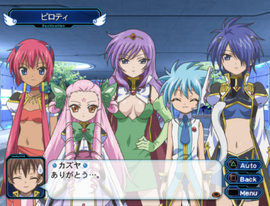
While the first game in the trilogy begins normally, the second and third games will have the player establish who Kazuya ended up with in the previous game. Adhering to the tradition of the series, a large portion of the Galaxy Angel II games remain a visual novel with combat segments mixed in. The player takes control of Kazuya Shiranami, the first male member of the new Rune Angel Wing stationed on the Luxiole and, like Tact from the previous trilogy, is responsible for maintaining the mental health of his teammates to ensure their best performance in the fights to come. The games are separated into a multitude of Chapters that are further separated into 4 acts, that can be selected to play from so as long as they were previously cleared. Akin to an anime, at the beginning and end of each Chapter, the selected Opening and the Ending theme for the game will play, often differing based on the Chapter's character focus.
Controls[]
- Square: Backlog
- Triangle: Auto-Read
- Circle: Remove HUD
- Cross: Confirm
- Select: Brings up the Menu to either Save the game, Load the game, Access options, or Return to the Menu.
- R1: Skip Text
Ship Exploration[]
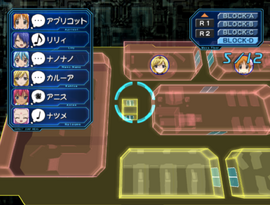
While the story continues through regular progression, Kazuya is given free time during his duties to check in with his teammates around the ship. Compared to Tact, Kazuya will have considerably more time exploring the ship to befriend his teammates and the Luxiole's crew. Whilst Tact had to rely on Kuromie and the Space Whale by visiting the Whale Room and use up time to determine the moods of the Angels, Kazuya receives the Telepathic Fur from Tact early on to replace the aforementioned visit to the Whale Room and has access to it at all times. Similarly to how the Whale Room begins to be irrelevant with succeeding games, raising affection in the successive titles only exist to gain increased stats in relevant fights.
In nearly every free roam section for Tact, he would have 30 minutes (6 visits in total) to walk around the ship and do what needs to be done. For Kazuya, it remains essentially the same but some chapters will only feature 4 visits while sometimes, it can go up to 12. Nonetheless, it is completely up to the player to interact with the Angel Wing positively or visit the other facilities of the ship. One thing to note is that in the original series, visiting a room with two angels would mean taking a side with one of them and losing a point with the other, while for Kazuya, he could have the chance to earn points with both Angels. Maintaining high levels of approval is made easier by "jumping back" to previously read lines through the backlog option. Another new small addition is that Kazuya can visit an Angel that was previously visited in the same or different room and strike a short conversation with her or see her interact with someone else without taking up a time slot. Some of these short encounters provide another chance to raise their mood.
Affection[]
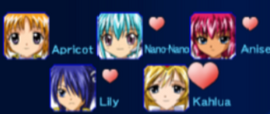
In first game in the trilogy, the level of affection Kazuya builds up with his team until Chapter 8 will continue to accumulate and when the time comes, he will have to make one choice between up to 3 girls out of the 5 to be his partner. Unlike the first game of the previous trilogy, there is no backing out of the relationship that Tact could potentially make the mistake of doing (as that technically is reserved for an extra disc's Kazuya Route to set up for Natsume). From then on, the route is locked in on and in following games, Kazuya's partner is chosen at the very beginning of each game. Interestingly, the player has a choice to determine which Moon Angel Troupe member Tact himself ended up with and will have a similar scenario involving 6 wallscrolls that determine his wife. Kazuya can see his current overall levels of Affection seeing the size of the "Hearts" that denote the Affection from his teammates in the Save/Load Screen as well as pressing Select during Ship Exploration where a musical note will denote their mood.
Trust[]
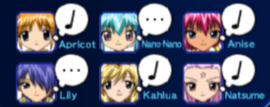
In the successive games, Kazuya's partner is already set in stone by the Heroine Select in the beginning of the game. Understandably, the Affection Stat becomes obsolete and is replaced with Trust, a temporary stat compared to the cumulative effects of Affection. Building up Trust is basically the same as raising Affection as it consists of the doing the same activity of raising the team's morale through conversations and the likes in both the regular VN Segments and visiting them in Ship Exploration. Trust will increase the given Angel's stats for the next fight while your already romanced Angel will receive a boost no matter what. Trust levels can be seen by either the Save/Load screen from the or be denoted in the Free Roam section by pressing Select where a musical note will denote their trust. Trust is reset back to "0" after a Chapter's completion.
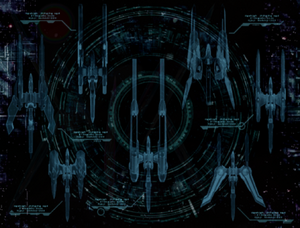
Combat[]
For better or for worse, the combat has been stream-lined and relies on essentially a single button. Once again, you take to combat by having control over the flagship Luxiole, and the 5 (later 6, but at max, 7) Emblem Frames into combat.
Before each fight, Kazuya will be able to select from 1 of 6 (technically 7) Angels to merge Emblem Frames with. Depending on how the player did in raising everyone's spirits in the usually preceding Ship Exploration segment, the effect of merging Emblem Frames can either have weakened effects, no effect, or have extremely positive benefits. Which of these effects taking place will be shown in the white outline in comparison to the orange data graph that shows the default statistics as well as how the stats have changed according to Kazuya's prior actions.
Going clockwise:
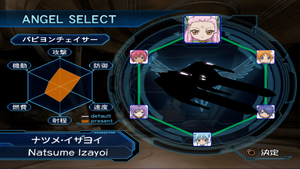
- Attack
- Defense
- Speed
- Range
- Energy Consumption
- Maneuverability
Controls in Tactical Mode (Default)[]
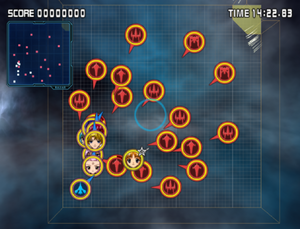
The default starting mode of each fight. This gives you a tactical view of the map, where the enemies are, where your units are. Most of the fight should be monitored from this mode. The color scheme from the first trilogy applies. Blue outlined ships are ones under your direct control, green are allies that can be controlled, yellow denotes neutrality and are non-combatants, and red represent hostiles.
- Select: Bring up Options during pause
- Start: Skip Intro Dialogue, Pause
D-Pad (Camera)[]
- Up
- Down
- Left
- Right

Analog Sticks[]
- R-Up
- L-Up (No effect)
- R-Down
- L-Down (No effect)
- R-Left
- L-Left (No effect)
- R-Right
- L-Right (No effect)
Face Buttons[]
- Square: Select All
- Triangle: Bring up options of ships that can change behavior. Necessary for Nano to switch between Needle Flechette and Repair Wave.
- Set Ship behavior "Search": After they defeat an enemy, they automatically seek another or can be ordered to await further orders after.
- Set Ship Behavior "Counter": Prioritize enemies that attack the selected ship or await orders on an explicit target.
- Set Ship Behavior "Hyper Weapon": Automatically issue the usage of a ship's Hyper Weapon when available or wait for manual targeting.
- Set Ship Behavior "Resupply": Set a percentage of energy remaining for when a ship will automatically return to the Luxiole to restore its energy.
- Set Ship Behavior "Repair": Set a percentage of HP remaining for when a ship will automatically request repair orders from the First Aider.
- Circle: Select for Attack (select enemy next), Guard (select ally next), Resupply (select Luxiole next), or Repair (only for Nano)
- Cross: Cancel selection
Side Buttons[]
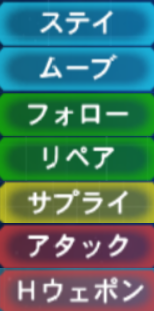
- R1: Zoom Out
- R2: Zoom In
- R3: Cinematic Mode (See below)
- L1: (No Effect)
- L2: Bring up Status (Shows health-bars, energy, and special gauges of all Emblem Frames, Switch between Controllable Ships, Enemies, and Allies)
- L3: Firing Mode (See Below)
Controls in Cinematic Mode (Pressing R3 on top of a ship)[]
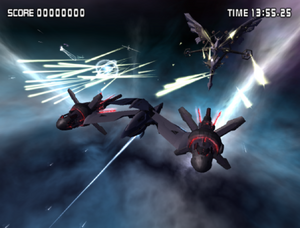
Cinematic Mode shows the battle from the front lines. You can utilize the Left Analog Stick to control the camera and the Side buttons to either zoom in or out of scenery. This is not recommended for actually playing the game but more for seeing the scenery.
- Select: Bring up Options during pause
- Start: Skip Intro Dialogue, Pause
D-Pad (Camera)[]
- Up: (No effect)
- Down: (No effect)
- Left: (No effect)
- Right: (No effect)
Analog Sticks[]
- R-Up
- L-Up (No effect)
- R-Down
- L-Down (No effect)
- R-Left
- L-Left (No effect)
- R-Right
- L-Right (No effect)
Face Buttons[]
- Square: Select All
- Triangle: Bring up options of ships that can change behavior. Necessary for Nano to switch between Needle Flechette and Repair Wave.
- Circle: Select for Attack (select enemy next), Guard (select ally next), Resupply (select Luxiole next), or Repair (only for Nano)
- Cross: Cancel selection
Side Buttons[]
- R1: Zoom Out
- R2: Zoom In
- R3: Exit Cinematic Mode
- L1: (No effect)
- L2: Bring up Status (Shows health bars, energy, and special gauges of all Emblem Frames)
- L3: (No effect)
Controls in Firing Mode (Pressing L3)[]
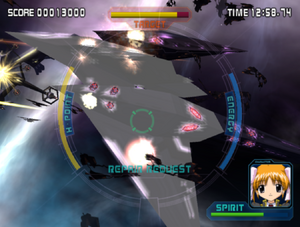
Essentially the newest feature of the series where Kazuya can take to the field and fight alongside his teammates. Kazuya can enter Firing Mode where the chosen Emblem Frame will attack and engage on a targeted enemy and eventually move in close enough for Kazuya to use the auxiliary guns to shoot down enemy projectiles and parts of the ship itself. This allows you to deal with key targets with increased damage, increased special meter gain, but also less tactical versatility, and extra damage gained.
- Select: Bring up Options during pause, Request Repairs
- Start: Skip Intro Dialogue, Pause
D-Pad (Camera)[]
- Up: (No effect)
- Down: (No effect)
- Left: (No effect)
- Right: (No effect)
Analog Sticks[]
- R-Up: (No effect)
- L-Up (No effect)
- R-Down: (No effect)
- L-Down (No effect)
- R-Left: (No effect)
- L-Left (No effect)
- R-Right: (No effect)
- L-Right (No effect)
Face Buttons[]
- Square: (No effect)
- Triangle: Use Hyper Weapon
- Circle: Lock-on for targets for the Heroine's Emblem Frame to shoot at.
- Cross: Shoot
Side Buttons[]
- R1: Slows speed
- R2: (No effect)
- R3: (No effect)
- L1: Boost Speed to the Left
- L2: Bring up Status (Shows health bars, energy, and special gauges of all Emblem Frames)
- L3: Exit Firing Mode
Trivia[]
References[]
| Project G.A. | |||||
|---|---|---|---|---|---|
| Animes | Galaxy Angel | Galaxy Angel Z | Galaxy Angel A/AA/S | Galaxy Angel X | Galaxy Angel Rune | ||||
| Books | Galaxy Angel | Galaxy Angel Beta | Galaxy Angel Party | Galaxy Angel 3rd | Galaxy Angel II Angel's Wing Resting | ||||
| Official Games | Galaxy Angel | Galaxy Angel Moonlit Lovers | Galaxy Angel Eternal Lovers | Galaxy Angel EX | CR Galaxy Angel | Galaxy Angel II: Gate to the Absolute | Galaxy Angel II: Key to the Infinite Corridor | Galaxy Angel II: Eternal Recurrence | ||||
| Related Games | Galaxy Angel Dawn of Huskarl | GA Angel Soldier A - Dual Angels | Galaxy Angel Dating Sim RPG | ||||
| Others | Performers | Staff | | Merchandise | Radio_Programs | Informational Shows | Musicals | Songs | ||||










